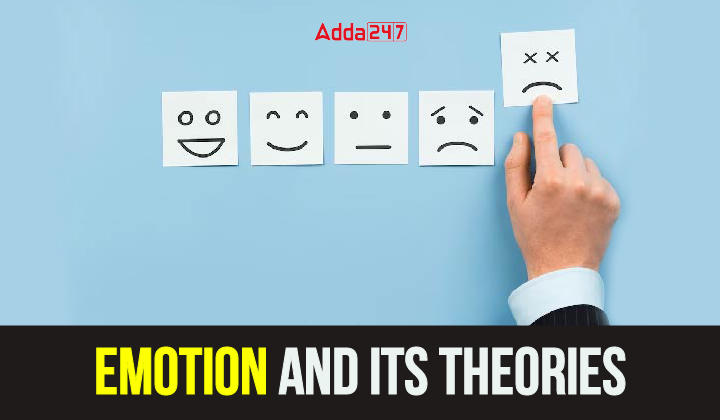Table of Contents
The exploration of emotion and its theories assumes a central role, delving into the intricate landscape of how children perceive, experience, and express emotions. This section scrutinizes prominent theories that elucidate the development of emotional intelligence, social awareness, and emotional regulation in children, offering valuable insights for educators and caregivers to foster holistic emotional growth and well-being.
What Is Emotion?
The term emotion is derived from Latin term “emovere” which means to stir, to agitate, to move. Hence, an emotion is referred to as a stirred up state of the organism. Emotion is often defined as a complex state of feeling that results in physical and psychological changes that influence thought and behavior.
Characteristics of Emotions
(i) Emotion is a stirred up state of the organism.
(ii) It is a specific condition of the mind.
(iii) Emotion is a feeling of pleasantness and unpleasantness.
(iv) An emotion is always aroused by a certain stimulus.
(v) The same stimulus may arouse different emotions.
(vi) Maturation plays an important role in emotional development.
(vii) There are objective and subjective factors in the development of emotions.
(viii) Emotion is more intense than feeling.
Component of Emotions
- Cognitive: The emotions experienced by the individuals are dependent on the situation whether it is classified as dangerous or innocuous as a consequences of thinking.
- Physiological: Emotions also affect the physical body & influence it, for example, emotions cause sweating, increased blood pressure, increased rate due to fear or excitement.
- Experiential: This feeling can be experienced by humans only as they have ability to reflect how an experience affects the emotions.
- Expressive: Emotions can be conveyed through facial expression or hand and body gestures. Like nodding your head can be used to affirm a yes or a no. Anger or happiness can be expressed by frowning or smiling.
- Behavioural: Confronted by a situation in which fight or flight are the only options are indicative of a pattern of behaviour influnced by the person’s emotional state.
Theories of Emotion
There are positive emotions and negative emotions, and these emotions can be related to an object, an event, social emotions, self-appraisal emotions, etc. Some emotions are innate. For example: love, care, joy, surprise, anger and fear. These are known as primary emotions. Secondary emotions are those that we learn through our experience. For example: pride, rage, shame, neglect, sympathy and horror.
James-Lange Theory
The James-Lange theory of emotion was proposed by psychologists William James and Carl Lange. According to this theory, as we experience different events, our nervous system develops physical reactions to these events. Examples of these reactions include increased heart rate, trembling, upset stomach, etc. These physical reactions in turn create emotional reactions such as anger, fear and sadness.
For example, imagine sitting in a dark room all by yourself. Suddenly you hear breathing sound behind you. Your heart rate increases and you may even begin to tremble. You interpret these physical responses as you are scared and so you experience fear.
Cannon-Bard Theory
The Cannon-Bard theory of emotion was developed by physiologists Walter Cannon and Philip Bard. According to this theory, we feel the emotions and experience the physiological reactions such as sweating, trembling and muscle tension simultaneously.
For example, you are in a dark room all by yourself and suddenly you hear breathing sound nearby. According to the Cannon-Bard theory, your heart rate increases and you begin to tremble. While you are experiencing these physical reactions, you also experience the emotion of fear.
Schachter-Singer Theory
The Schachter-Singer theory of emotion was developed by Stanley Schachter and Jerome E. Singer. According to this theory, the element of reasoning plays an important role in how we experience emotions.
The Schachter-Singer theory suggests that when an event causes physiological arousal, we try to find a reason for this arousal. Then we experience and label the emotion.
For example, you are sitting in a dark room all by yourself and all of a sudden you hear breathing sound behind you. Your heart rate increases and you begin to tremble. Upon noticing these physical reactions, you realize that they come from the fact that you are all alone in a dark room. You think that you may be in danger, and you feel the emotion of fear.
Schachter-Singer’s Two-Factor Theory
This theory focuses on the role of physiological arousal as a primary factor in emotions. However, it also suggests that physical arousals alone cannot be responsible for all the emotional responses. Therefore, it takes into account the cognitive aspect of the emotional reaction.
For example, you are sitting in a dark room all by yourself and all of a sudden you hear breathing sound behind you. Your heart rate increases and you begin to tremble. You notice the increased heart rate and realize that it is caused by fear. Therefore, you feel frightened.


 TN TRB Assistant Professor Notification ...
TN TRB Assistant Professor Notification ...
 DSSSB TGT Social Science Syllabus 2024 P...
DSSSB TGT Social Science Syllabus 2024 P...
 Bihar STET 2024 Study Plan, Practice Qui...
Bihar STET 2024 Study Plan, Practice Qui...








